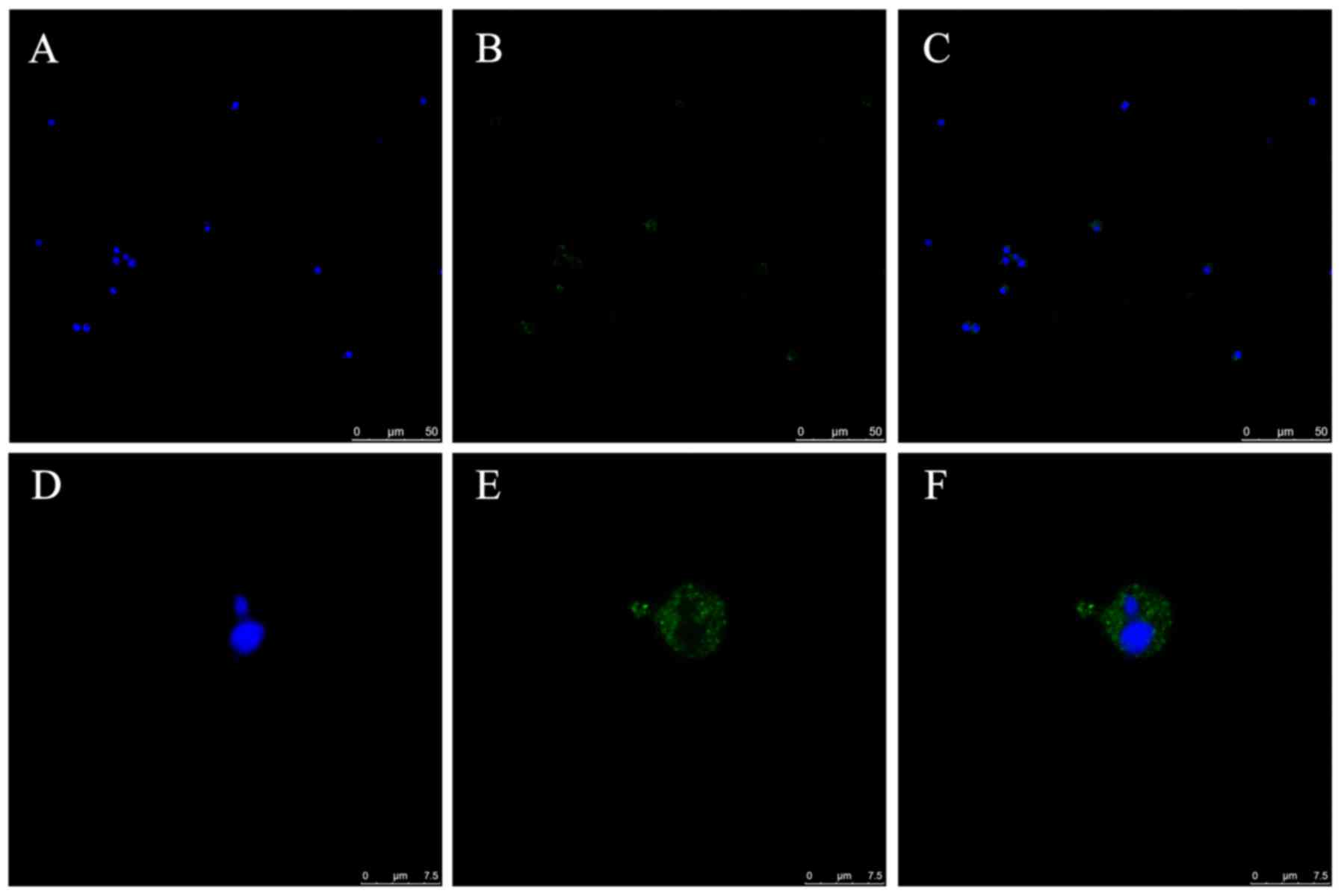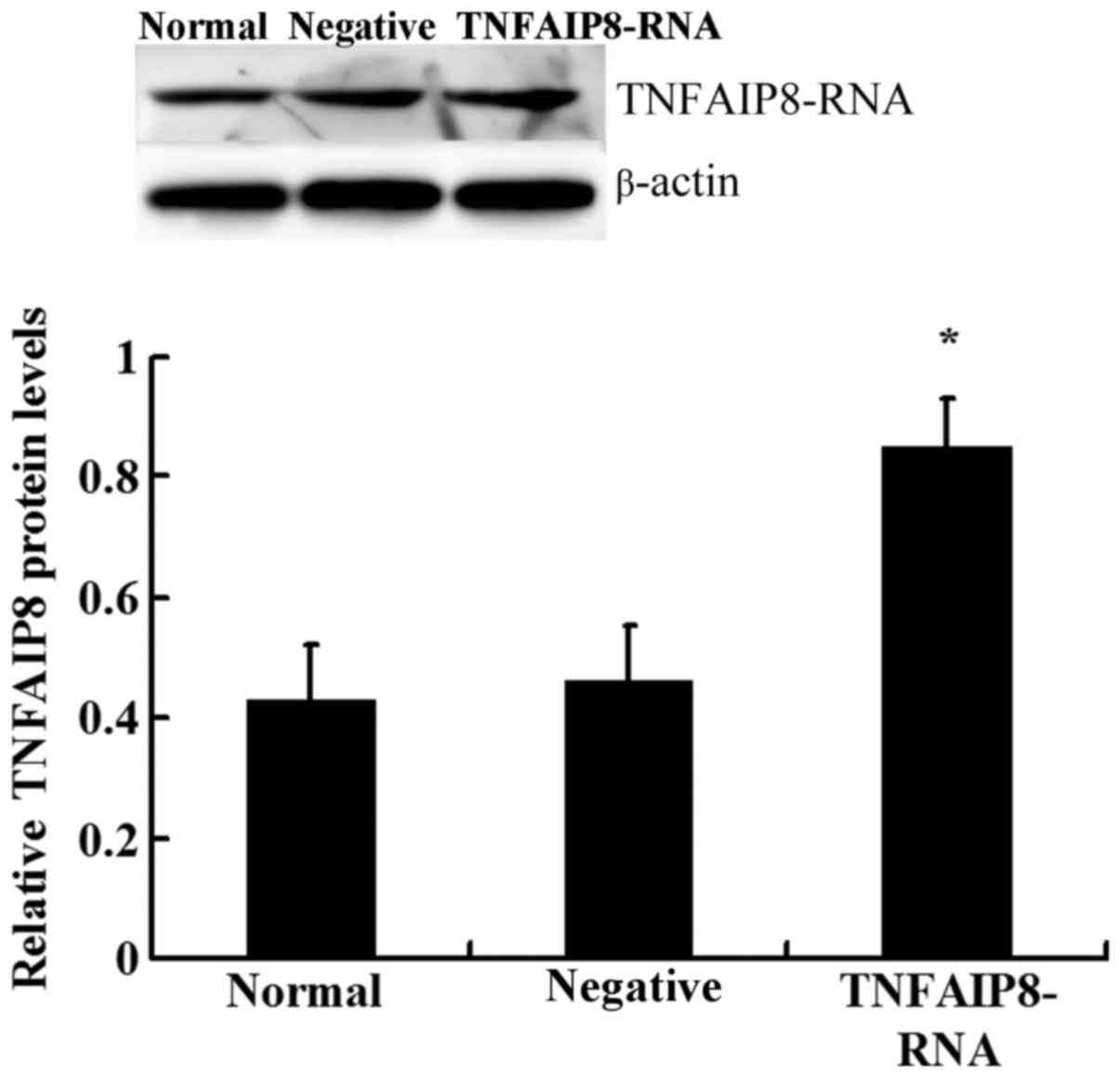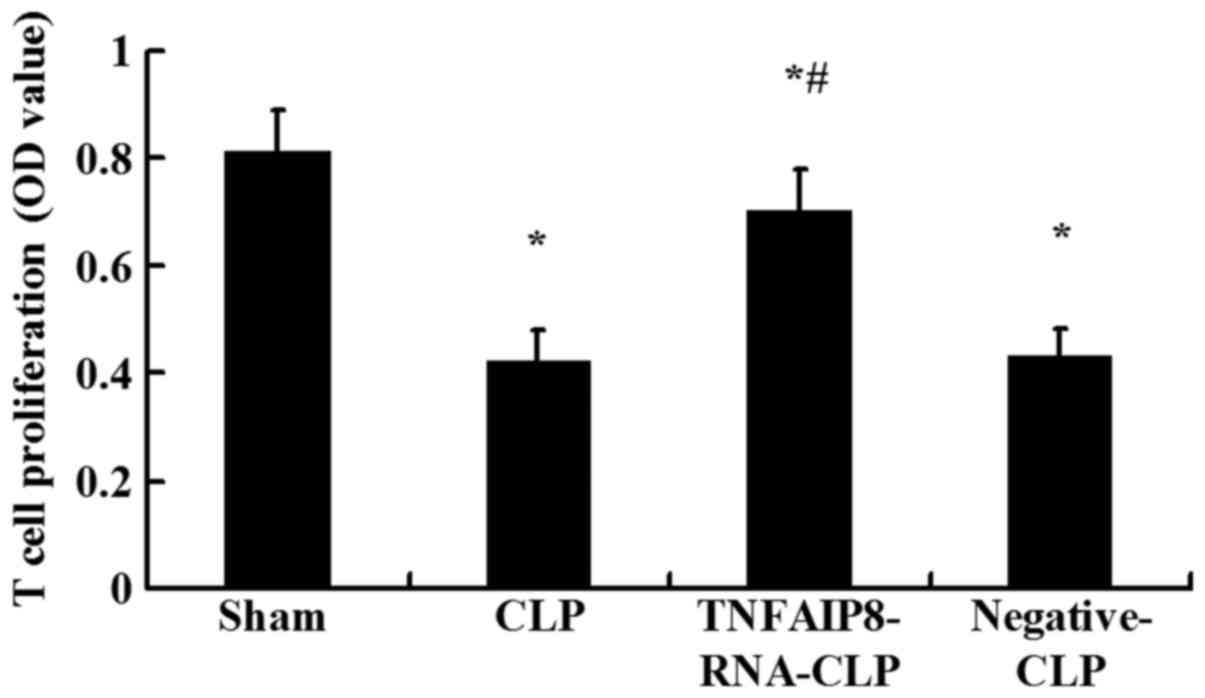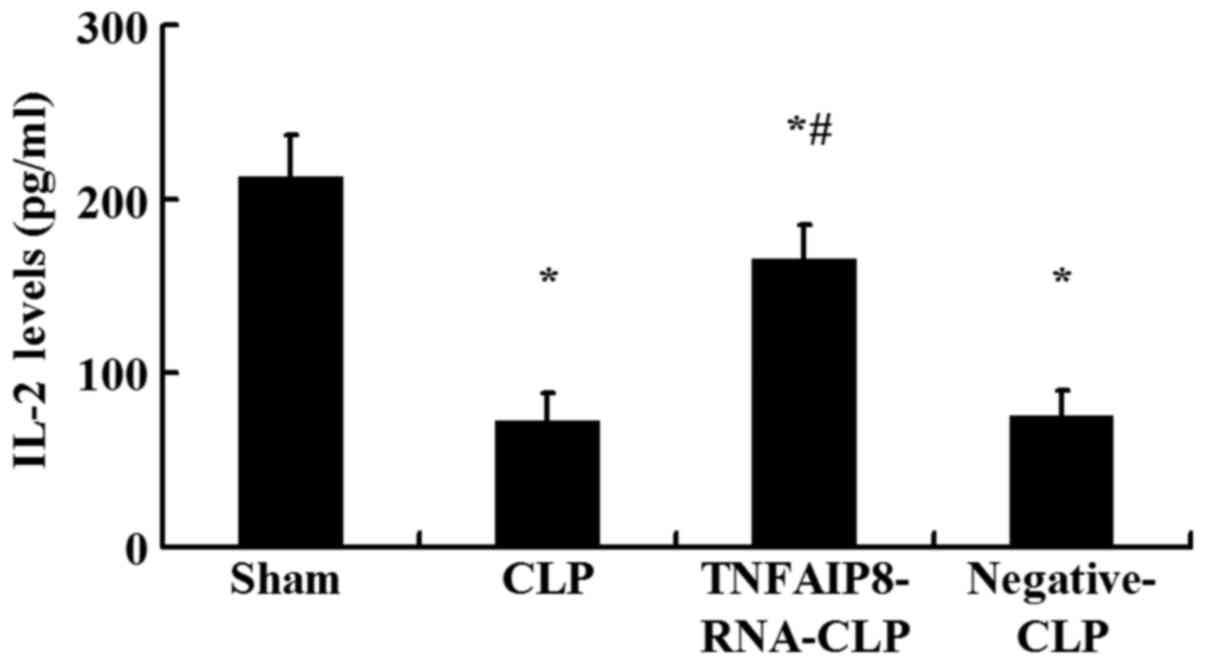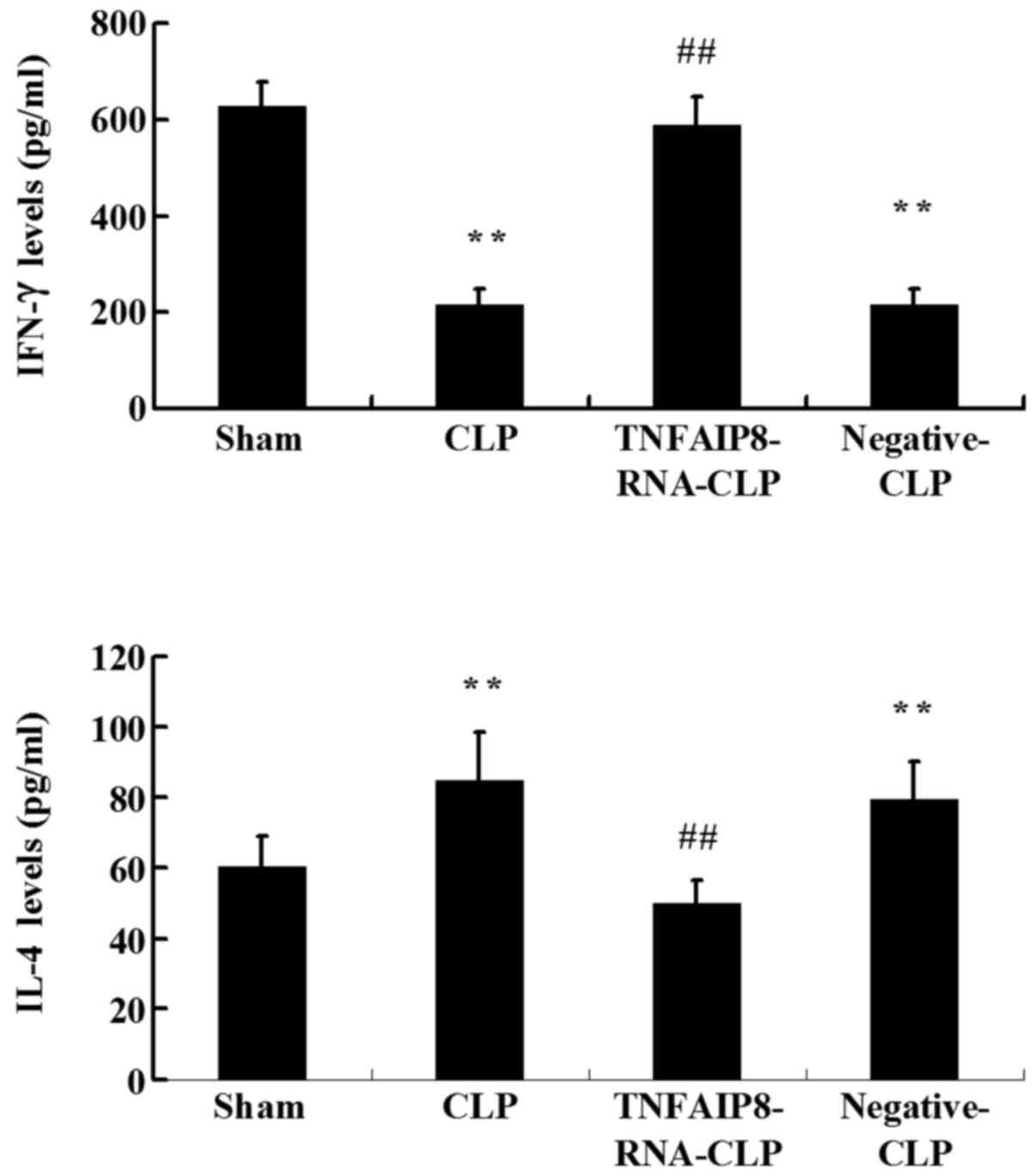Effect of tumor necrosis factor-α-induced protein 8 on the immune response of CD4+ T lymphocytes in mice following acute insult
- Authors:
- Published online on: February 27, 2018 https://doi.org/10.3892/mmr.2018.8639
- Pages: 6655-6660
Abstract
Introduction
Sepsis is a complex clinical syndrome that results in the widespread activation and dysfunction of innate and adaptive immunity (1,2). In the development of sepsis, several lines of evidence have suggested that T cells are involved in the maintenance of peripheral homeostasis and regulation of the immune response, and are considered not only the effector cells but also the modulator cells in the immune response during sepsis (3–5). Subjection to acute insult alters T cells by inducing an imbalance in T helper (Th) cell functions, caused by a phenotypic imbalance in the regulation of the Th1 and Th2 immune response.
Tumor necrosis factor-α (TNF-α)-induced protein 8 (TNFAIP8), which is also known as SCC-S2, GG2-1 and MDC-3.13, was the first identified member of the TNFAIP8 family. TNFAIP8 was originally detected in a primary human head and neck squamous cell carcinoma (HNSCC) cell line and its matched metastatic HNSCC-derived cell line from the same patient, as determined by expression profile analysis (6). TNFAIP8 is associated with enhanced cell survival and inhibition of proapoptotic enzymes, including caspase-8 and caspase-3, and depends on the activation of nuclear factor-κB and TNF-α in human cancer cells (7). Since T lymphocytes are also essential in cell-mediated immunity in the setting of acute injury, it was hypothesized that TNFAIP8 may be associated with the immune regulation mediated by cluster of differentiation (CD)4+ T cells. Therefore, the present study aimed to investigate the potential effects of TNFAIP8 on T cell-mediated immunity in cecal ligation and puncture (CLP)-induced sepsis.
Materials and methods
Ethics statement
The present study was approved by the 309th Hospital of Chinese People's Liberation Army Medical Research Ethical Committee (Beijing, China). Male C57BL/6 mice (n=100) were purchased from Shandong University Animal Ethical Committee (Jinan, China), and were 8–10 weeks old at the time of entry into the present study.
Medium and reagents
Triton X-100 and MTT were purchased from Sigma-Aldrich; Merck KGaA (Darmstadt, Germany). RPMI-1640 medium was purchased from Hyclone; GE Healthcare Life Sciences, (Logan, UT, USA), supplemented with 10% fetal bovine serum (FBS; Gibco; Thermo Fisher Scientific, Inc., Waltham, MA, USA) The CD4+ T cell Isolation kit was purchased from Miltenyi Biotec GmbH (Bergisch-Gladbach, Germany. Anti-CD3 and anti-CD28 monoclonal antibodies were purchased from BD Biosciences (Affymetrix, San Jose, CA, USA; cat. nos. 16-0022 and 16-0281, respectively). The enhanced chemiluminescence (ECL) plus chemiluminescence kit was purchased from GE Healthcare Life Sciences (Uppsala, Sweden). ELISA kits for interleukin IL-2 (cat. no. EM002-96), IL-4 (cat. no. EM003-96) and interferon IFN-γ (cat. no. EM007-96) were purchased from Shanghai ExCell Biology, Inc. (Shanghai, China).
Murine CLP model
Male C57BL/6 mice used in the present study (weight, 18–22 g) were provided by the Shandong University Animal Ethical Committee. All animals were housed in separate cages in a temperature-controlled room at 26°C under a 12-h light/dark cycle. All animals had free access to food and water. Polymicrobial sepsis was induced by the CLP procedure, as described by Wichterman et al (8). Briefly, anesthesia was induced through the intraperitoneal administration of thiopental (25 mg/kg), the mice were placed in a supine position and their abdomens were shaved. An abdominal midline incision of 1 cm was made to expose the cecum. According to Rittirsch et al (9), the cecum was ligated at the middle and punctured twice with a 21-gauge (0.73-mm) needle to induce sepsis of moderate severity. Sham-operated mice underwent the same laparotomy procedure with the exception of ligation and perforation.
Experimental design
In the present study, 100 mice were randomly divided into four groups as follows: Sham injury group (n=30), CLP group (n=30), CLP with lentivirus-RNA-TNFAIP8 group (n=20) and CLP with negative control group (n=20). Mice in all groups were sacrificed 24 h following CLP, and spleen samples were harvested for the isolation of CD4+ T cells.
TNFAIP8 RNA lentivirus generation and infection
Small RNA specific to TNFAIP8 was synthesized by GenchemBiotetchnology Company (Shanghai, China), the sequence was as follows: 5′-CCGGCATGGAGAAGTTCAAGAAGAATTCAAGAGATTCTTCTTGAACTTCTCCATGTTTTT-3′. To induce overexpression of TNFAIP8, recombinant lentiviruses [pFH-L lentiviral vector (Shanghai GeneChem Co., Ltd., Shanghai, China)], carrying TNFAIP8-RNAwere injected intraperitoneally at a multiplicity of infection (MOI) of 109 TU/ml into mice 14 days prior to CLP injury. Concomitantly, the same concentration of recombinant lentiviruses that carried the negative control RNA (empty vector; Shanghai GeneChem Co., Ltd.) was injected at an MOI of 5×108 TU/ml into the mice, which served as a wild type control. TNFAIP8 and negative control RNA lentivirus generation was performed according to the lentivirus vector particle manufacturer's protocol. The efficiency of overexpression was determined by western blot analysis of TNFAIP8 expression.
Isolation of splenic CD4+ T cells
Spleens were obtained from the sham mice and CLP mice, and were cultured in 5 ml RPMI-1640 medium. Mononuclear cells were isolated with the use of Ficoll-Paque density gradient centrifugation at 1,500 × g for 15 min at 4°C, according to the manufacturer's protocol, and CD4+ T cells were isolated from them using the CD4+ T cell isolation kit according to the manufacturer's protocol. Mononuclear cells (10 µl/107 total cells) were stained with a biotin-antibody cocktail (MiltenyiBiotec GmbH, BergischGladbach, Germany; cat. no. 130049201) and incubated for 10 min at 4°C. They were then magnetically labeled with anti-biotin MACS microbeads (20 µl/107 total cells; MiltenyiBiotec GmbH), incubated for 15 min at 4°C, and harvested through a negative selection LS column (MiltenyiBiotec GmbH).
Western blot analysis
Western blotting was performed to determine the expression of TNFAIP8 in the extracted CD4+ T cells. Cells were lysed by radioimmunoprecipiation lysis buffer [25 mM Tris-HCL (pH 7.6), 150 mM NaCl, 1% NP-40, 1% sodium deoxycholate, 0.1% SDS] at the temperature of 0°C for 30 min. Following sonication for 5 sec, the lysed cells were then centrifuged at 12,000 × g for 30 min at 4°C. Protein levels were quantified using a bicinchoninic acid protein assay kit. Protein extracts (50 µg) were separated by 8% SDS-PAGE, and the products were electro transferred to an immobilon polyvinylidene difluoride membrane. Following blocking with 10% skim milk overnight at 4°C, the membrane was incubated for 4 h at room temperature with anti-TNFAIP8 polyclonal antibody (cat. no. ab64988; 1:500 dilution; Abcam, Cambridge, MA, USA) or control anti-β-actin antibody (cat. no. sc-130201; 1:500; Santa Cruz Biotechnology, Inc., Dallas, TX, USA). The membrane was then washed three times with PBS and incubated with peroxidase-labeled mouse IgG secondary antibody (cat. no. A0548; 1:5,000; Sigma-Aldrich; Merck KGaA) for 1 h at room temperature. As aforementioned, the membrane was washed with PBS three times, and blots were then developed using the ECL plus chemiluminescence kit (Pierce; Thermo Fisher Scientific, Inc.). The protein bands were detected using an ECL detection system (Pierce; Thermo Fisher Scientific, Inc.).
Confocal microscopy analysis
CD4+ T cells with density of 106/ml in the normal group were washed with PBS three times, fixed with 4% paraformaldehyde in PBS for 20 min, then permeabilized with 0.2% Triton X-100 for 20 min both at room temperature. Sections were pre-blocked with 1% FBS in PBS for 30 min, and stained with anti-TNFAIP8 antibody (cat. no. ab64988; 1:200; Abcam) overnight at 4°C. Following washing three times in PBS, CD4+ T cells were stained with a fluorescein isothiocyanate-conjugated goat anti-immunoglobulin G secondary antibody (cat. no. C1309; 1:5,000; Applygen Technologies Inc., Beijing, China) for 1 h at room temperature followed by three further washes in PBS. Following washing, the nuclei were stained with 4′,6-diamidino-2-phenylindole for 5 min at room temperature. The cells were observed under a laser scanning confocal microscope.
T cell proliferation assay and cytokine measurements
Purified CD4+ T cells were cultured in RPMI-1640 medium supplemented with 10% heat-inactivated FBS, and were stimulated for 24 h for CD4+ activation with a combination of 1 µg/ml soluble anti-CD3 and 1 µg/ml soluble anti-CD28 monoclonal antibodies at 37°C. The T cells were then plated in 96-well plates at a density of 1×105 cells/well, and were incubated at 37°C in 5% CO2 for 68 h. Subsequently, modified MTT solution (5 mg/ml, 10 µl/well) (10–12) was added and the cells were incubated for a further 4 h, after which 100 µg acid isopropanol was added to dissolve the MTT crystals. The MTT crystal suspension was repeatedly mixed with a pipette, and the optical density was measured using a microplate reader at a wavelength of 540 nm.
To analyze the secretion of IL-2, IL-4 and IFN-γ into the culture medium of the cells, the supernatants obtained from CD4+ T cells were analyzed, and the supernatants were removed by pipetting. The levels of IL-2, IL-4 and IFN-γ were measured using commercially available ELISA kits according to the manufacturer's protocols.
Statistical analysis
All data in the present study are presented as the mean ± standard deviation of 3 independent experiments. Continuous data were examined by one-way analysis of variance followed by a post hoc Dunnett's test for multiple comparisons. SPSS 13.0 software (SPSS, Inc., Chicago, IL, USA) was used to perform these statistical analyses. P<0.05 was considered to indicate a statistically significant difference.
Results
TNFAIP8 expression in CD4+ T cells
The expression and distribution of TNFAIP8 protein in CD4+ T cells isolated from normal mice was investigated by means of confocal laser scanning microscopy. Green fluorescence was observed in the cytoplasm of the CD4+ T cells, with their nuclei stained blue (Fig. 1A-F).
Splenic T lymphocyte proliferation following CLP-induced sepsis
In the present study, the effects of TNFAIP8 on proliferative activity of CD4+ T cells in a CLP mouse model were observed. TNFAIP8 was successfully upregulated following injection of mice with lentivirus-RNA-TNFAIP8 (Fig. 2). Western blot analysis revealed that the protein expression levels of TNFAIP8 were significantly upregulated in the TNFAIP8 overexpression group compared with the control groups (Fig. 2). The proliferative activity of splenic CD4+ T cells was significantly suppressed 24 h following CLP compared with the sham injury group (P<0.05; Fig. 3). To further clarify the involvement of TNFAIP8 in the decreased cell proliferation observed following CLP-induced sepsis, the effects of upregulated TNFAIP8 were determined in vivo 24 h following CLP. Compared with the CLP group, proliferative activity was significantly increased in the CLP with TNFAIP8 overexpression group (P<0.05; Fig. 3), indicating that TNFAIP8 may be closely associated with the immune functions of CD4+ T cells.
IL-2 production
IL-2 is a potent T cell growth factor that acts upon itself in an autocrine fashion. The levels of IL-2 in culture supernatants of CD4+ T cells were measured by ELISA. Following 24 h of CLP, IL-2 production in the culture supernatant was significantly downregulated compared with in the sham-injured group (P<0.05; Fig. 4). Conversely, IL-2 expression levels were significantly higher following TNFAIP8 upregulation by lentivirus-RNA-TNFAIP8 infection in vivo compared with the CLP group, whereas no significant difference was observed between the negative control CLP and CLP groups (Fig. 4). It was noted that excessive TNFAIP8 expression was associated with the increased IL-2 levels secreted by CD4+ T cells.
Polarization of T cells following sepsis
It is possible for an immune response to become polarized towards either Th1 or Th2 production over time; therefore, one subtype or the other dominates. It is well known that Th1 cells produce IFN-γ and Th2 cells produce IL-4; therefore, ELISA was used in the present study to detect these T cell-produced cytokines, in order to identify the polarization of naive T cells. The results revealed that the levels of IFN-γ produced by CD4+ T cells were significantly reduced, and that the levels of IL-4 were significantly increased at 24 h in the CLP group compared with the sham group (P<0.01; Fig. 5). Furthermore, a significant increase in IFN-γ and a significant decrease in IL-4 were detected in CD4+ T cells following TNFAIP8 overexpression in the CLP-induced sepsis group (P<0.01; Fig. 5). Taken together, these results suggested that TNFAIP8 may affect T cell polarization following sepsis.
Discussion
Sepsis represents a complex clinical condition that results from a damaging host response to infection. Considerable data have demonstrated that acute insults, including major burns, trauma and hemorrhage, may result in T cell immune suppression, which is associated with the loss of function of the Th1 lymphocyte phenotype (13–17). TNFAIP8 has been demonstrated to be associated with enhanced survival and inhibition of proapoptotic enzymes, including caspase-8 and caspase-3, and participates in cell death, transcriptional regulation, migration, proliferation and apoptosis (7,18). In addition to high expression in tumor tissue, TNFAIP8 is also highly expressed in immune organs and lymphoid tissues; however, its function in the immune system remains unclear. In the present study, experiments were conducted to verify the potential effect of TNFAIP8 upregulation on the CD4+ T cell-mediated immune response in a CLP murine model
During experimental and clinical sepsis, T cells are critical cellular components of immunity, which are essential for an effective immune response to acute insults or septic challenge. A previous study demonstrated that TNFAIP8 was expressed in CD4+ and CD8+ T cells, and the mRNA and protein levels were significantly decreased in tumor-infiltrating CD4+ and CD8+ T cells compared with peripheral CD4+ and CD8+ T cells (19). In the present study, confocal laser scanning microscopy was used to orientate TNFAIP8 protein expression, and TNFAIP8 protein was revealed to be expressed in the cytosol of CD4+ T cells, thus suggesting that TNFAIP8 may be involved in the immune response. The present study suggested that TNFAIP8 expression may be involved in the pathogenesis of CD4+ T cell immune dysfunction in mice during sepsis, whereas TNFAIP8 overexpression significantly improved the immune function of CD4+ T cells. The results demonstrated that the proliferation of splenic CD4+ T cells was significantly inhibited 24 h following CLP and that overexpression of TNFAIP8 in vivo attenuated the suppression of splenic T lymphocyte proliferative activity 24 h following CLP. Therefore, TNFAIP8 may be involved in development of the impairment of immune function of T lymphocytes in CLP-induced sepsis.
IL-2 is a key regulator of the immune response, which is secreted by activated T lymphocytes and is essential to activate T lymphocyte proliferation (20,21). IL-2 production was significantly inhibited in CD4+ T cells from CLP mice compared with in those from sham-injured mice. However, this suppression was ameliorated by TNFAIP8 upregulation in vivo. Therefore, TNFAIP8 may affect IL-2 secretion by T lymphocytes in the setting of acute insult and further modulate activation of T lymphocytes.
It has been reported that proliferation of T lymphocytes is suppressed and modulation of Th1, as well as Th2, is shifted in sepsis (22–25). Notably, in animal models of injury, the release of IL-2 and IFN-γ produced by Th1, and IL-4 produced by Th2 was altered (25). In the present study, splenic CD4+ T cells were demonstrated to develop into Th2 cells in animals subjected to CLP. To further clarify the potential effect of TNFAIP8 on CD4+ T cells, TNFAIP8 was upregulated. TNFAIP8 overexpression was demonstrated to initiate a CD4+ T cell to shift to Th1 following CLP. These results indicated that increased expression of TNFAIP8 may influence the polarization of splenic T cells. Nevertheless, the present study has limitations. Nuclear factor of activated T cells, which was the first characterized transcription factor that binds to the IL-2 promoter, should be used to study the effects of TNFAIP8 on the immune functions of CD4+ T cells. Furthermore, different time points following CLP should be studied.
In conclusion, based on the results of the present in vivo study, TNFAIP8 was demonstrated to be associated with the development of the splenic T lymphocyte immune response in mice following CLP-induced sepsis. However, numerous key issues remain to be resolved. It remains unclear how TNFAIP8 signaling controls the immune function of T lymphocytes, or what the association is between TNFAIP8 and other molecules in cell-mediated immunity. Further studies investigating the precise mechanism of action of TNFAIP8 are therefore required.
Acknowledgements
Not applicable.
Funding
The present study was supported by the National Natural Science Foundation of China (grant no. 81470043) and the Department Military Medicine and Geriatric Diseases Research Fund (grant no. ZCWS14B04).
Availability of data and materials
The analyzed data sets generated during the study are available from the corresponding author on reasonable request.
Authors' contributions
MC conceived the study. BY and LX designed the process of this study. LX, BY and DZ performed the experiments. SL analyzed the experimental results. BY and LX wrote the paper. DZ and SL reviewed and edited the manuscript. All authors read and approved the manuscript.
Ethics approval and consent to participate
The present study was approved by the 309th Hospital of Chinese People's Liberation Army Medical Research Ethical Committee (Beijing, China).
Consent for publication
Not applicable.
Competing interests
The authors declare they have no competing interests.
References
|
Oberholzer A, Oberholzer C and Moldawer LL: Sepsis syndromes: Understanding the role of innate and acquired immunity. Shock. 16:83–96. 2001. View Article : Google Scholar : PubMed/NCBI | |
|
Weber GF and Swirski FK: Immunopathogenesis of abdominal sepsis. Langenbecks Arch Surg. 399:1–9. 2014. View Article : Google Scholar : PubMed/NCBI | |
|
Gatewood MO, Wemple M, Greco S, Kritek PA and Durvasula R: A quality improvement project to improve early sepsis care in the emergency department. BMJ Qual Saf. 24:787–795. 2015. View Article : Google Scholar : PubMed/NCBI | |
|
Khakpour S, Wilhelmsen K and Hellman J: Vascular endothelial cell Toll-like receptor pathways in sepsis. Innate Immun. 21:827–846. 2015. View Article : Google Scholar : PubMed/NCBI | |
|
Delano MJ and Ward PA: Sepsis-induced immune dysfunction: can immune therapies reduce mortality. J Clin Invest. 126:23–31. 2016. View Article : Google Scholar : PubMed/NCBI | |
|
Kumar D, Whiteside TL and Kasid U: Identification of a novel tumor necrosis factor-alpha-inducible gene, SCC-S2, containing the consensus sequence of a death effector domain of fas-associated death domain-like interleukin-1beta-converting enzyme-inhibitory protein. J Biol Chem. 275:2973–2978. 2000. View Article : Google Scholar : PubMed/NCBI | |
|
You Z, Ouyang H, Lopatin D, Polver PJ and Wang CY: Nuclear factor-kappa B-inducible death effector domain-containing protein suppresses tumor necrosis factor-mediated apoptosis by inhibiting caspase-8 activity. J Biol Chem. 276:26398–26404. 2001. View Article : Google Scholar : PubMed/NCBI | |
|
Wichterman KA, Baue AE and Chaudry IH: Sepsis and septic shock-a review of laboratory models and a proposal. J Surg Res. 29:189–201. 1980. View Article : Google Scholar : PubMed/NCBI | |
|
Rittirsch D, Huber-Lang MS, Flierl MA and Ward PA: Immunodesign of experimental sepsis by cecal ligation and puncture. Nat Protoc. 4:31–36. 2009. View Article : Google Scholar : PubMed/NCBI | |
|
Singh MP, Rai AK and Singh SM: Gender dimorphism in the progressive in vivo growth of a T cell lymphoma: Involvement of cytokines and gonadal hormones. J Reprod Immunol. 65:17–32. 2005. View Article : Google Scholar : PubMed/NCBI | |
|
Huang LF, Yao YM, Zhang LT, Dong N, Yu Y and Sheng ZY: The effect of high-mobility group box 1 protein on activity of regulatory T cells after thermal injury in rats. Shock. 31:322–329. 2009. View Article : Google Scholar : PubMed/NCBI | |
|
Zhang Y, Yao YM, Huang LF, Dong N, Yu Y and Sheng ZY: The potential effect and mechanism of high-mobility group box 1 protein on regulatory T cell-mediated immunosuppression. J Interferon Cytokine Res. 31:249–257. 2011. View Article : Google Scholar : PubMed/NCBI | |
|
Shinkai K, Mohrs M and Locksley RM: Helper T cells regulate type-2 innate immunity in vivo. Nature. 420:825–829. 2002. View Article : Google Scholar : PubMed/NCBI | |
|
Miller AC, Rashid RM and Elamin EM: The ‘T’ in trauma: The helper T-cell response and the role of immunomodulation in trauma and burn patients. J Trauma. 63:1407–1417. 2007. View Article : Google Scholar : PubMed/NCBI | |
|
Ma T, Han L, Gao Y, Li L, Shang X, Hu W and Xue C: The endoplasmic reticulum stress-mediated apoptosis signal pathway is involved in sepsis-induced abnormal lymphocyte apoptosis. Eur Surg Res. 41:219–225. 2008. View Article : Google Scholar : PubMed/NCBI | |
|
Lang JD and Matute-Bello G: Lymphocytes, apoptosis and sepsis: Making the jump from mice to humans. Crit Care. 13:1092009. View Article : Google Scholar : PubMed/NCBI | |
|
Kasten KR, Tschop J, Adediran SG, Hildeman DA and Caldwell CC: T cells are potent early mediators of the host response to sepsis. Shock. 34:327–336. 2010. View Article : Google Scholar : PubMed/NCBI | |
|
Valmiki MG and Ramos JW: Death effector domain-containing proteins. Cell Mol Life Sci. 66:814–830. 2009. View Article : Google Scholar : PubMed/NCBI | |
|
Wang L, Song Y and Men X: Variance of TNFAIP8 expression between tumor tissues and tumor-infiltrating CD4+ and CD8+ T cells in non-small cell lung cancer. Tumour Biol. 35:2319–2325. 2014. View Article : Google Scholar : PubMed/NCBI | |
|
Zhang G, Hao C, Lou Y, Xi W, Wang X, Wang Y, Qu Z, Guo C, Chen Y, Zhang Y, et al: Tissue-specific expression of TIPE2 provides insights into its function. Mol Immunol. 47:2435–2442. 2010. View Article : Google Scholar : PubMed/NCBI | |
|
Sharma A, Yang WL, Matsuo S and Wang P: Differential alterations of tissue T-cell subsets after sepsis. Immunol Lett. 168:41–50. 2015. View Article : Google Scholar : PubMed/NCBI | |
|
Abboushi N, El-Hed A, El-Assaad W, Kozhaya L, El-Sabban ME, Bazarbachi A, Badreddine R, Bielawska A, Usta J and Dbaibo GS: Ceramide inhibits IL-2 production by preventing protein kinase C-dependent NF-kappaB activation: Possible role in protein kinase Ctheta regulation. J Immunol. 173:3193–3200. 2004. View Article : Google Scholar : PubMed/NCBI | |
|
Cuenca AG, Delano MJ, Kelly-Scumpia KM, Moreno C, Scumpia PO, Laface DM, Heyworth PG, Efron PA and Moldawer LL: A paradoxical role for myeloid-derived suppressor cells in sepsis and trauma. Mol Med. 17:281–292. 2011. View Article : Google Scholar : PubMed/NCBI | |
|
Diosa-Toro MA, Jaimes BFA, Rugeles LMT and Velilla HPA: Cells with immunoregulatory properties and their impact in the pathogenesis of sepsis. Rev Chilena Infectol. 28:572–578. 2011.(In Spanish). View Article : Google Scholar : PubMed/NCBI | |
|
Condotta SA, Cabrera-Perez J, Badovinac VP and Griffith TS: T-cell-mediated immunity and the role of TRAIL in sepsis-induced immunosuppression. Crit Rev Immunol. 33:23–40. 2013. View Article : Google Scholar : PubMed/NCBI |



